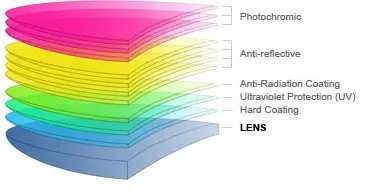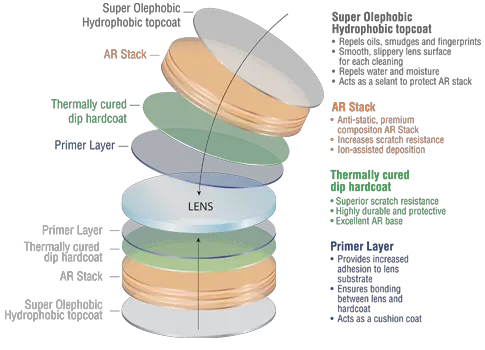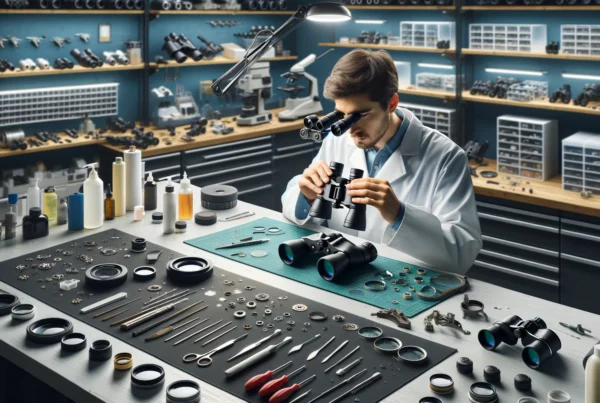Contents
- Binoculars Lens Coating — An Overview
- Types of Lens Coating
- Types of Phase Correction Coating — General Comparison
- How do Binoculars Lens Coating Work?
- What are the Benefits of Binoculars Lens Coating?
- How are Lens Coatings applied?
- What is the Best Way to Determine the Lens Coating in Binoculars?
- Which type of Lens Coating is Best?
- Bottom Line
A high-quality pair of binoculars is a valuable investment. To get the most out of your binoculars, it is important to understand how the different lens coatings can impact your viewing experience.
Binoculars lens coating can be a helpful way to improve the performance of binoculars. It is a thin film that is applied to the surface of the lenses and is designed to reduce reflections and increase the amount of light that is transmitted through the lenses. Binoculars with lens coating typically have better image quality than those without it.
Some binoculars have special purpose coatings, such as those that help to increase contrast or reduce eye fatigue. These coatings can be applied to either the front or back surface of the lens, depending on their purpose.
Binoculars Lens Coating — An Overview
A binoculars lens coating is a type of anti-reflective optical coating that is applied to the surface of a lens to reduce reflection and glare and to improve the performance of binoculars. This coating helps to reduce the amount of light that is reflected off of the lens surface, which can improve the clarity and brightness of the image that is seen through the binoculars.
Some binoculars are also available with specialized coatings that are designed for specific applications, such as night vision or low-light conditions. Binoculars that have lens coating typically cost more than those that do not, but the benefits of the coating can be worth the extra cost.
Types of Lens Coating
- Single Coated
- Fully Coated
- Multi Coated
- Phase Correction Coating
Single Coated vs Fully Coated vs Multi Coated— General Comparison
| Fully Coated | Multi Coated |
| Fully coated binoculars have lenses that are coated with multiple layers of anti-reflective material. | Binoculars with multi-coated lenses produce images that are bright and clear. |
| This helps to reduce glare and improve image quality. | This type of coating helps to reduce glare and reflections, and also increases the amount of light that is transmitted through the lenses. |
| The lense coating are made with a layer of primer and the anti-reflective material to adhere to the lens surface. The primer also helps to fill in any imperfections on the lens surface. | There are many ways to make multi coated binoculars lens coating, but one of the most common ways is to vacuum-deposit thin layers of dielectric material onto the lens surface. |
| This type of coating is typically applied to less expensive binoculars in order to increase light transmission and reduce reflection. | In general, expensive binoculars have multi-coated lenses to improve light transmission. |
| Benefits | Benefits |
| The main advantage of fully coated binoculars lenses is that they allow more light to reach the eye, which results in a brighter image. | It reduces reflections from the lenses, which increases the contrast and clarity of the image. Finally, it helps to protect the lenses from scratches and other damage. |
Phase Correction Coating— An Overview
Phase Correction Binoculars lens Coating is a material that is applied to the surface of lenses to improve the performance of the lens.The coating helps to reduce the amount of light that is reflected off the surface of the lens, which can cause glare and reduce the amount of light that is transmitted through the lens.
Moreover, phase correction coatings are designed to reduce or eliminate the amount of chromatic aberration that occurs in binoculars. Chromatic aberration is an optical effect that occurs when light waves of different colors are refracted by a lens in different amounts. This can cause the images produced by the binoculars to be distorted.
Types of Phase Correction Coating — General Comparison
- Anti-Reflective (AR) Coatings
- Ultraviolet (UV) Coatings
- Infrared (IR) Coatings
Anti-reflective (AR) Coatings vs Ultraviolet (UV) Coatings vs Infrared (IR) Coating — General Comparison

| Anti-Reflective (AR) Coatings | Ultraviolet (UV) Coatings | Infrared (IR) Coating |
| Anti-reflective binoculars lens coating is typically applied to the surface of the binoculars lenses in order to reduce the amount of light that is reflected off of the lens. | Ultra violet coatings are designed to reduce the amount of ultraviolet light that passes through the lens of a binocular. | Infrared coatings are special types of coatings that are applied to the lenses of binoculars. |
| This can help to improve the overall clarity and contrast of the image that is seen through the binoculars. | This can improve the quality of the image by reducing the amount of haze and blue light that is scattered in the atmosphere. | These coatings help to reduce the amount of infrared light that is reflected off of the lenses. Infrared coatings can also help to reduce glare and improve contrast. |
| This type of coating is applied to the front surface of the lens and is designed to reduce the amount of light that is reflected off of the lens by up to 95%. | Some binoculars have multiple layers of ultra violet coatings that provide even more protection from UV light. These coatings can also help to reduce the amount of glare that is reflected off of the lens surface. | This increases the amount of infrared light that is able to pass through the lens, making the image appear brighter. |
| Benefits | Benefits | Benefits |
| Anti-reflective (AR) coatings on binoculars lenses are beneficial that they can help reduce glare and reflections, and improve light transmission. These can also help to protect the lenses from scratches and other damage. | Benefits of UV coatings include improved light transmission, reduced reflections, and increased protection from the elements. UV coatings can also help to reduce eye fatigue by blocking out harmful UV rays. | Some of the benefits of infrared coatings are that they help to reduce reflections, absorb light, and improve the overall clarity of the binoculars. |
How do Binoculars Lens Coating Work?
Binoculars lens coating work by providing a thin layer of material on the surface of the lens that helps to reduce reflections and increase the amount of light that is able to pass through the lens. This coating can be applied to both the inside and outside of the lens, and is typically made from a variety of different materials, such as magnesium fluoride or silicon dioxide.
What are the Benefits of Binoculars Lens Coating?

1. Reduce reflection and glare from the lens surface.
2. Improve light transmission through the lens.
3. Protect the lens surface from scratches and other damage.
4. Improve the overall contrast and image quality of the bin.
How are Lens Coatings applied?
Lens coatings are applied to the surface of the lens using a vacuum deposition process. A thin layer of material is vaporized in a high-vacuum chamber and then deposited onto the surface of the lens. The thickness of the coating is controlled by the duration of the deposition process.
In Addition,The lens coating is applied using a process called ion-assisted deposition. This process uses an electric field to accelerate particles of the coating material towards the surface of the lens. The particles then stick to the surface and build up the coating. There are typically 3-5 coats applied in this process.
What is the Best Way to Determine the Lens Coating in Binoculars?
The best way to determine the Lens Coating in binoculars is:
- Check the manufacturer’s website or specifications.
- Look for a label or sticker on the binoculars that indicates the type of coating.
- Look for a reflection when you hold the lens up to a light source.
Which type of Lens Coating is Best?
Different types of lens coatings can be better for different purposes. Some common types of lens coatings include anti-reflective, UV-resistant, and phase correction coatings.
Some factors that may influence your decision include the type of lens you are using, the environment in which you will be using the lens, and your personal preferences.
If you are looking for a lens coating that will help to reduce reflections, then an anti-reflective coating may be the best option for you. If you are looking for a lens coating that will help to protect your lenses from scratches, then a scratch-resistant coating may be the best option for you.
Bottom Line
No matter what type of binoculars you own, the quality of the lens coating can have a big impact on your viewing experience. The type of coating that you choose will depend on the amount of light that you need to transmit through the lens, the level of protection that you need for the lens, and the budget that you have for the project.
Many binoculars have multiple layers of lens coating, which can include anti-reflective layer, a UV-resistant layer, and a layer that helps to reduce glare.Some of the benefits of single coated binoculars lens coatings include increased light transmission, reduced reflections, and increased durability.

A Binoculars enthusiast, who love exploring skies and watching birds. It is my hobby to collect Binoculars of different kinds and try to explore the world through various lenses. This is all I do to explore happiness by magnifying my beautiful world.




